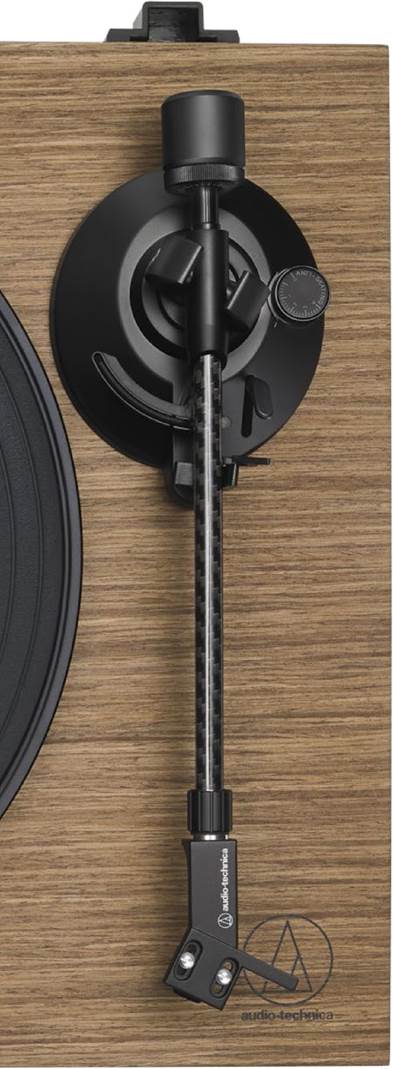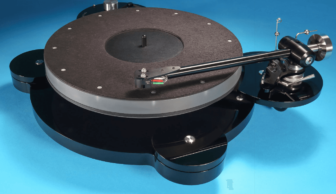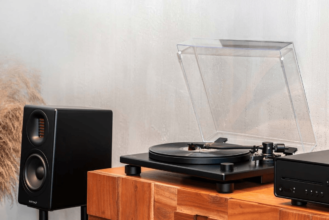Audio-Technica AT-LPW40WN Review
Ah, the relaxing joys of spending time with the black stuff! This LP spinner from Audio-Technica cuts out the convenience features to concentrate firmly on getting the best sound for your investment. Read our Audio-Technica AT-LPW40WN Review.
It’s a great time to buy a turntable, with record companies continuing to ramp up the release of recordings new and old on vinyl, the second-hand LP market thriving through record fairs, and regular new turntable releases as well — when only a decade ago it was thought that the models still available might be the last vinyl spinners ever designed.
Audio-Technica, of course, had long since diversified into headphones, microphones and other equipment, but never abandoned the black stuff, and also has the merit of nearly 60 years experience in cartridge manufacture — it was founded for that purpose in 1962 by Hideo Matsushita, cousin to the founding family of what is now Panasonic (and Technics), and remains a
Japanese company of great renown. So dominant is it in the cartridge business that a great many other brands of turntable arrive bearing an Audio- Technica cartridge (even if some prefer to use unbranded versions to maintain their company pride), while in recent years the company itself has released a surge of new turntable models which have established benchmark performance at prices from entry-level up. Can the AT-LPW40WN do the same, and what differentiates it from the rest of the range?
EQUIPMENT
If you’re looking for a turntable, there are a number of fundamental choices, and indeed Audio-Technica is one company that has been expanding these choices recently with new technology. You can get USB turntables that can connect to your computer (mainly to make recording vinyl easier). There are Bluetooth turntables which can send their output wirelessly to a Bluetooth speaker or headphones. There are automatic turntables which start at the press of a button, move the arm across and drop it gently on the record, and then do the reverse when you reach the end of the side.

These can all be handy things if you want them, but they all take funds away from the truly important stuff, and some might even interfere with the audio quality. So if you can do without them, you’ll likely get a higher-quality cartridge, or a better power supply and speed control, or a higher-level of plinth isolation — the things that can really contribute to the sound.
And that seems more the focus of the AT-LPW40WN. There’s no digitisation of the output here; the turntable is firmly analogue.
It’s fully manual — you move the arm yourself, and you’ll be required to lift it off again when it reaches the end groove of your LP.
The one nod to convenience is that it offers two levels of output. It can be used like any other turntable, with its phono-level output playing through a phono stage or the phono input of an amplifier. But it also has an electronics section within. This includes its own phono stage, so at the rear you can flick a switch to deliver a line-level output instead of phono-level, making the LPW40WN suitable for any amplifier, whether equipped with a phono input or not.
This is a belt-drive turntable; Audio-Technica also makes direct drive turntables (pioneered by cousin Technics) where the platter is driven directly by the motor. Each style has its advantages and disadvantages — for direct drive durability and quick start-up are the pluses (good for DJs), whereas the main negative is the lack of isolation from the motor, and the possibility of ‘cogging’, tiny speed variations inherent to the rotor-stepping operation of any electronic motor. That’s enough for most sound-orientated users to choose belt drive, the belt providing a level of isolation which can reduce vibrational noise and shocks to yield a cleaner sound. (Downsides of belts? Over time they can loosen and require replacement.)
The cartridge here is the well-regarded AT-VM95E with an elliptical stylus, coming pre-mounted in an AT-HS4 universal half-inch mount headshell. This cartridge has the merit of a replaceable stylus (some don’t, so that you have to buy a whole new cartridge), though given there’s not too much price-differential between the AT-VMN95E stylus and a new AT-VM95E, the main merit may be just not having to install and align a new cartridge! (Should you ever wish to mug up on all things cartridge and stylus, Audio-Technica has an excellent primer which we’ve linked at avhub.com.au/AT.) How often should you change your stylus? Some say 1000 hours of play, some say less or more. We say listen, and you’ll know when.
The tonearm is a straight, carbon-fibre design, effective length 22.4cm. The motor is augmented by a speed-sensor system and feedback to achieve improved speed stability, and you make the change from 33 1/3 to 45rpm using the small knob on the left side of the plinth, which is itself a solid base, being MDF with the attractive walnut veneer finish shown in the images here — it presents as a high-quality traditional turntable, rather than some modernist new-fangled machine.
PERFORMANCE
Set-up proved simple enough once we’d detached the various bits from the multilayered packaging; we suspect that Audio-Technica must have a special relationship with some manufacturer of sticky tape, so much of the stuff is used to pack the mat and the platter, the headshell and the counterweight, the two lid hinges and the other pieces that require assembly to complete the deck. The belt is pre-attached around the underside of the platter so you just need to loop it over the pulley — avoid touching it with your greasy fingers if you can!
The headshell slots into the arm and is held in place by a screw-up ring collar, then you roll the counterweight up the back of the arm until perfect weightlessness of balance is achieved, dial in the proscribed 2g of tracking weight, the same amount on the tiny antiskate wheel (the arrow mark is near-invisible but the manual indicates where it is), and you’re done.
All easy, and with full instructions provided, even newbies need not fear. We checked cartridge alignment and it seemed spot on as pre-installed in the headshell. The hardest bit was actually ramming the Perspex lid into the tight grip of the hinges.
The connection to your amplifier (or external phono stage) is made with detachable flying leads complete with earth spade. If using the built-in phono stage to deliver a line-level output, then you can leave the earth cable unconnected.
We listened both ways — from its straight phono-level output, and at line-level straight into an amplifier using the turntable’s built-in phono stage. Of course, the quality you’ll achieve from the first option, its direct phono output, is dependent on the phono stage you add. We used three different external phono stages, one of them being the separate phono box reviewed in this issue, the others built into amplifiers priced at $ and $ . The internal electronics held up remarkably well against these, but the best of the external phono amps showed that there is more to be delivered from the LPW40 if you do give it a good separate stage. Interestingly this was not an upgrade to more shimmering treble but rather an improvement in tone, a filling out of the lower mids along with a calming of higher frequencies in violins and percussion that could, in relative terms, start running towards edginess from the inbuilt phono stage.
But the differences were small variations on what proved an excellent turntable sound at the price — wide open, free of congestion and, depending on the quality of your vinyl, quiet.
One disc given its first ever play on this deck was side two of Kate Bush’s ‘Never for Ever’, from the first box of the recent four-volume remasters. We dropped the needle and turned up the amp, and the vinyl was so quiet we thought we were on the wrong input until the Ms Bush’s magnificent vocal kicked off The Wedding List. Imaging was also impressive, everything in its place, notably realistically tingy metallic ride in the left-channel, and the tonal differences between several sections of her vocal clear to hear. The deck’s ability to resolve the layers of sound on The Infant Kiss we thought well above its price bracket, while the bass, quite reserved on this album, was nevertheless solid and tightly controlled, not an ounce of flab, perfectly capturing John Giblin’s fretless on the always- alarming Breathing, Kate’s answer to ‘The Wall’.
A bit mellow for you? We followed up with Iron Maiden’s 2016 triple live, the guitars layering up a left-right wall of sound thrillingly as we blasted out The Number of The Beast; the centre combination of kick, snare and vocal were perhaps dynamically compressed a little compared with our reference Thorens TD 203, but that’s a little over double of the price, and the LPW40 was delivering this maelstrom of sound without the

least confusion of its parts, and projecting pinging side cymbals and crowd singalong over the top.
Just a little more surface noise on our 1987 Virgin Records copy of Ennio Morricone ‘Film Music’, but that disappeared under the astonishingly organic impact of the pan-pipes leading into the soaring strings of Once Upon A Time in America, while Gabriel’s Oboe (from ‘The Mission’) confirmed the LP40W’s ability to deliver the emotion of music, this short piece raising hairs as it surged over the underpinning harpsichord, which tapped away in its own little acoustic. Selecting particular tracks on this album, we found the finger lift to be easy to use, and the dropping between tracks nice and accurate. That lid makes an almost unavoidable microphonic clunk coming down, but it does do the job of protection against both sound and dust! RPM’s speed app confirmed speed within 1%, wow and flutter within 0.5%.
CONCLUSION
By minimising the modernist additions on other decks in its range, but still including that useful built-in phono stage, Audio-Technica has delivered a manual belt-drive turntable which is musical beyond its price bracket, a classic looker as well, and with an easily replaceable (even upgradeable) stylus. Top marks for the money.
- No-frills focus on sound quality
- Phono stage built-in if required
- Nice looker
- Fully manual
Speeds: 33-1/3 RPM, 45 RPM
Output levels: 4.0mV phono, 200mV nominal line (1kHz, 5cm/sec)
Tonearm: carbon-fibre, eff. length 223.6mm
Cartridge: AT-VM95E
Motor: DC servo w.
Active Speed Stabilization
Dimensions (whd): 420 x 117 x 340mm
Weight: 4.72kg without lid
Contact: Technical Audio Group
Telephone: 02 9519 0900
Website: www.audiotechnica.com.au
Verdict
Our winning turntable in this price break here takes almost entirely the opposite tack to the feature-laden Sony opposite. It does have a built-in phono stage, but otherwise minimises the additions in order to deliver a manual belt-drive turntable which is musical beyond its price — and a classic looker, while coming with an easily replaceable or upgradeable stylus, given audio-technica’s 60 years experience in cartridge manufacture. The other extras can be handy things if you want them, but they all take funds away from the truly important stuff, and some might even interfere with the audio quality. So if you can do without them, as here, and you’ll likely get a better cartridge, a power supply with speed control, or a higher level of plinth isolation — things that can really contribute to the sound.
And that seems more the focus of the AT-LPW40WN. There’s no digitisation of the output here; the turntable is firmly analogue. It’s fully manual too — you move the arm yourself, and you’ll be required to lift it off again when it reaches the end groove of your LP. The cartridge here is the well-regarded AT-VM95E with an elliptical stylus, coming pre-mounted in an AT-HS4 universal half-inch mount headshell. The tonearm is a straight, carbon-fibre design, effective length 22.4cm; the plinth is MDF with the attractive walnut veneer finish shown above here — it presents as a high-quality traditional turntable, rather than some modernist new-fangled machine. The result: excellent turntable sound for your $ — wide open, free of congestion and, depending on the quality of your vinyl, quiet. More info: www.audiotechnica.com.au
“JUDGES’ COMMENT”
By minimising extras and focusing on sound, audio-technica delivers a classic turntable that performs above its price.












The Audio Technica LPW40WM is a nice looking, minimalist, mid level Turntable with high end looks.
The straight arm is composed of carbon fiber, a normal high end feature. Another audiophile high end feature is the belt drive servo motor which monitors and auto corrects speed differentials. The walnut looking plinth is a nice touch and provides good isolation while the legs are adjustable with rubber isolation pads. There is tracking force and anti skid control.
It’s a full manual TT, without the normal extras that can drive up the price, but add nothing to sonic.
In short most of what one pays for is performance. And is does perform well. The AT VM95E cartridge/stylus provides very a nice sound and is easily upgraded through stylus purchase.
It has little shortcomings. High end cymbal clashes are delivered with energy, while bass sound is a nice and warm. The bass had a slight tendency to include a slight to rumble. There are a plenty of energy.
In all a very well designed turntable which looks great and sounds almost as good.
Fabulous review. Thank you.
Great review! I’ve been considering the AT-LPW40WN for a while now, and your insights on its sound quality and build really help. Love the design too! You’ve made my decision easier. Thanks!